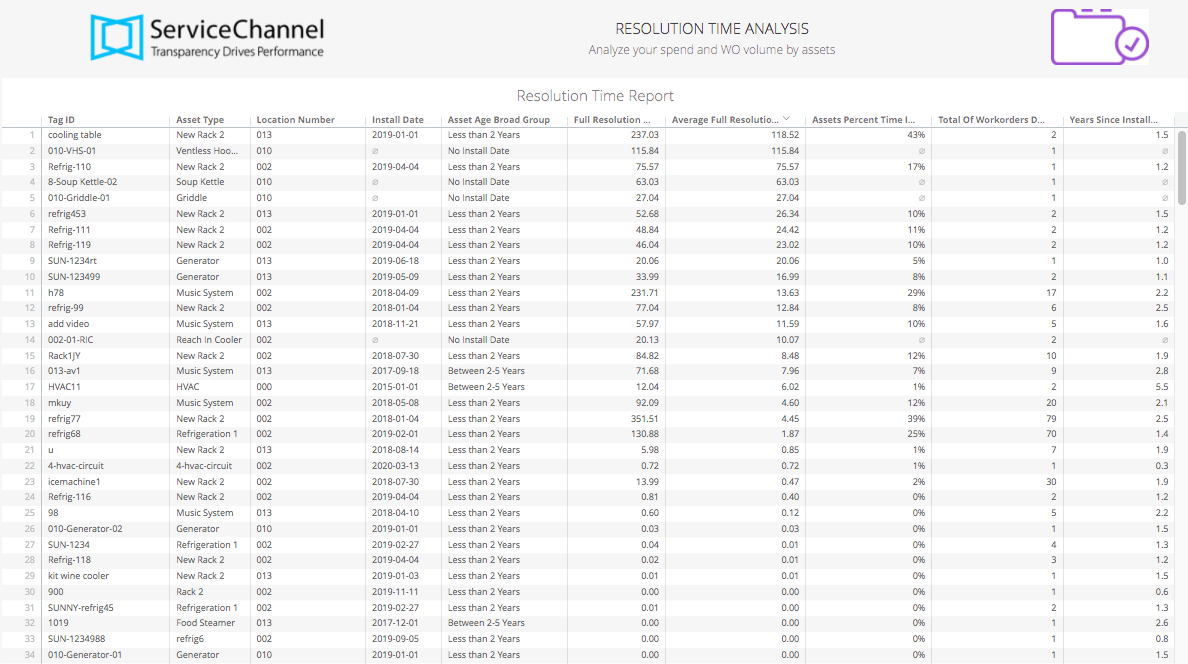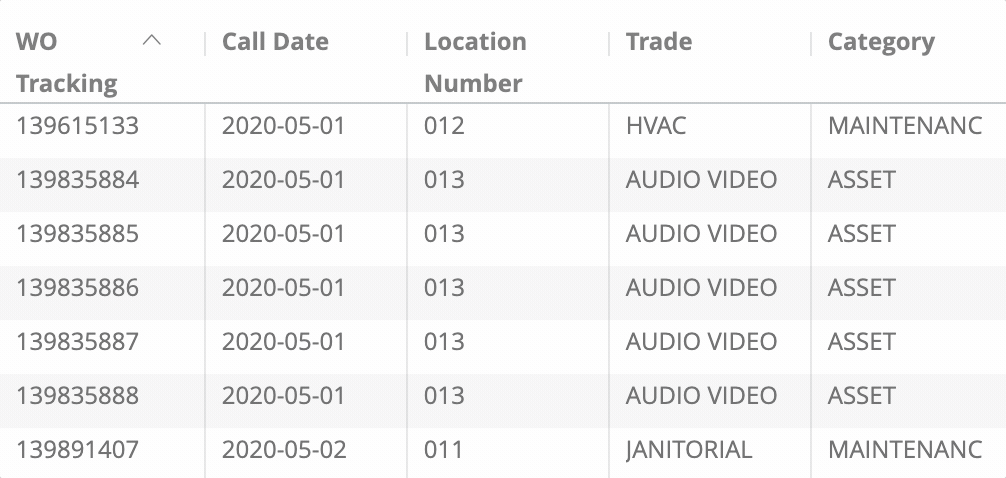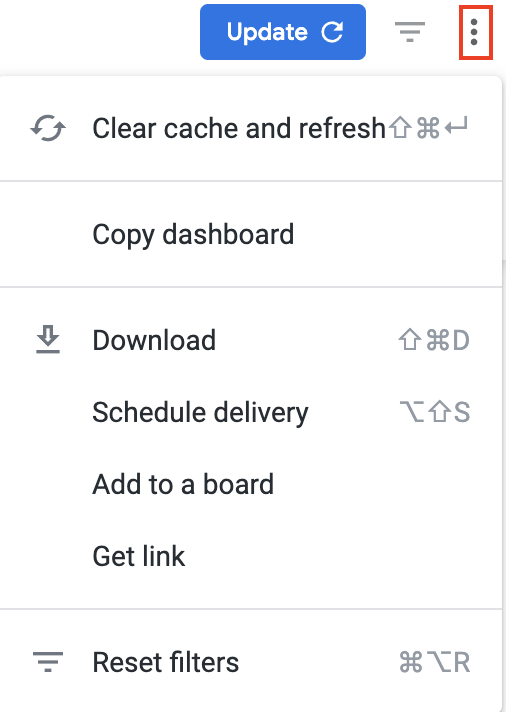Resolution Time Analysis Tab
Chellie Esters
Caroline Antoun
AJ Steele
The Resolution Time Analysis Tab displays the full, average and percentage of time it took for work orders with assets associated to be resolved. This report allows a user to see the percentage of time an asset is in a Repair state since it was installed, to help make repair or replace decisions.
Here, you can view the resolution time for work orders for the lifetime of each asset. Search criteria such as category, trade and location can be refined using the all-inclusive filters along the top of the report.
You can download the data and email reports to recipients.

Data in the Visualization
The following data is listed in the report, sortable by these column headers:
- Tag ID
- Asset Type
- Location Number
Install Date
Null values will appear if no install date is entered into asset manager
- Asset Age Broad Group: Based on the install date entered into asset manager and is grouped into No Install Date, Less than 2 years, Between 2-5 Years and Over 5 Years
Null values will appear if no work orders were entered against the asset
- Full Resolution Time Days: Sum of the days of the days that elapse from each work order creation date to the completion date
Average Full Resolution In Days
Assets Percent Time In Resolution
Total Of Work Orders Downtime
Years Since Install In Decimal
Below is a quick reference guide regarding tracking numbers in Analytics, filtering, sorting, downloading data, and sending reports. Throughout Analytics you can drill down into visualizations to see the underlying data. In most cases, the tracking numbers related to that data are listed. You can click the tracking number to navigate straight to the work order details in Service Automation. On top of the report are all-inclusive filters to help you hone in on key data. All reports on the page are affected by the criteria set in these all-inclusive filters. The filter criteria for each dashboard may differ. Filters reset to the default when the page is refreshed. Click filter field to show the criteria. Select the desired criteria to include or exclude: To Include criteria: select is equal to, contains, starts with, or ends with, and then begin typing the criteria in the picklist. Select the desired criteria (or multiple criteria) from the picklist. To exclude criteria: select is not equal to, does not contain, does not start with, or does not end with. Is null depicts the absence of data in a data set. Conversely, is not null depicts the presence of data To include or exclude data without a certain data criteria — for example, to select data without a Region or District assigned in Service Automation — choose is blank / is not blank. To add more options, click the plus sign (+) next to a field to add another option to the filter. The new option will appear as either an OR condition or an AND condition, depending on the type of filter option. Once all criteria are selected, click Refresh icon in the top-right corner. The Dashboard report updates with the selected criteria. More details are available on Filtering an Analytics Dashboard Analytics tables are dynamic, as you can: In the upper-right corner of any page, click the Vertical Ellipses to download reports, schedule delivery of reports at regular intervals, add to a board, or get a link. You can download data from a table and visualization or download a dashboard tabto PDF or CSV. Select the desired File Format and choose a File Name: A default name is listed but you can change it. On the desired dashboard (or dashboard tab), click the Gear icon in the upper-right of the page, and then click Download as PDF. The Download modal appears. A default Filename appears, but you can change it. Under Advanced options: Single-column format lays out all tables and visualizations on a page into one column in the PDF, as opposed to how it is laid out in the dashboard. Expand tables shows all rows in a table, instead of just the rows that appear on the dashboard. Paper size adjusts the PDF to your desired size. Click Open in Browser to view the PDF in your chosen browser, or click Download to save a version of the report onto your device. On the desired dashboard (or dashboard tab), click the Gear icon in the upper-right of the page, and then click Download as CSVs... A new browser tab opens. After the files render, you are prompted to save the CSV Zip file onto your device. More details are available on Downloading and Sending Dashboards and Reports You can also Send a one-time report via email or Schedule a recurring email send. On the desired dashboard (or dashboard tab), click the Gear icon in the upper-right of the page, and then click Send. The Send (Dashboard Name) modal opens. A Title is given by default, but you can change it. Under Who should it be emailed to?, enter the desired recipient(s), separated by a comma, and then click Add. (Optional) Click Include a custom message to add a personal note. Under Format data as, choose PDF, Visualization, or CSV Zip file. (Optional): Click Filters to limit the criteria that appear in the email. Note that the same filters on the dashboard itself will also appear here. Click Send. The email is sent to your recipients. On the desired dashboard (or dashboard tab), click the Gear icon in the upper-right of the page, and then click Schedule. The Schedule (Dashboard Name) modal opens. A Title is given by default, but you can change it. Under Who should it be emailed to?, enter the desired recipient(s), separated by a comma, and then click Add. (Optional) Click Include a custom message to add a personal note. Under Format data as, choose PDF, Visualization, or CSV Zip file. Under Deliver this schedule, choose Daily, Weekly, Monthly, Hourly, or By minute (in 5-minute increments, up to 30 minutes) (Optional): Use Filters to limit the criteria that appear in the email. Note that the same filters on the dashboard itself will also appear here. Click Send. The email is sent to your recipients. More details are available on Downloading and Sending Dashboards and ReportsCommonly Used Features
Tracking Numbers in Analytics
Filtering Dashboards
![]()
Dynamic Table Sorting

Downloading and Sending Reports


-
Page:
-
Page:
-
Page:
-
Page:
-
Page:
-
Page:
-
Page:
-
Page:
